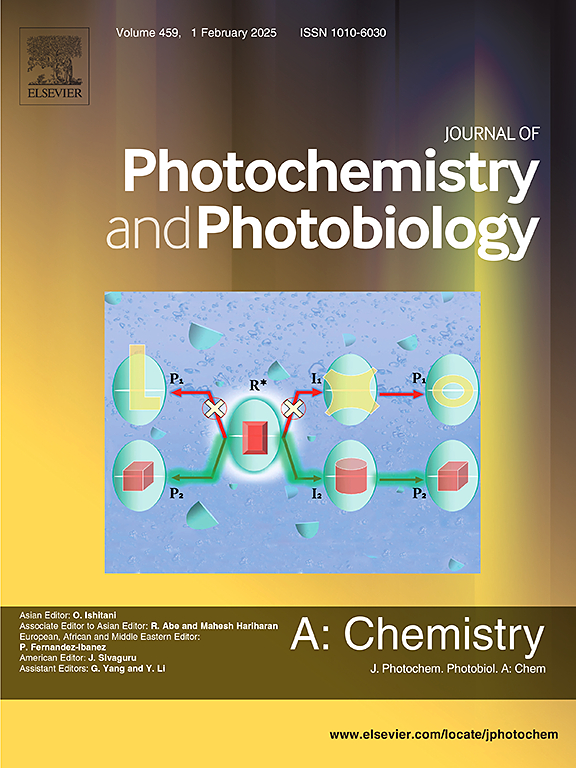硫离子化共轭卟啉,增强癌症治疗的光动力和光热效应
IF 4.1
3区 化学
Q2 CHEMISTRY, PHYSICAL
Journal of Photochemistry and Photobiology A-chemistry
Pub Date : 2024-10-12
DOI:10.1016/j.jphotochem.2024.116085
引用次数: 0
摘要
近年来,光疗因其精确的时间控制和微创性而成为一种前景广阔的癌症治疗方式。本文设计并合成了两种新型有机卟啉分子,分别称为 ONP 和 SNP,具有受体-供体-受体(A-D-A)结构。分子中的供体-受体(D-A)对促进了分子间电荷转移(ICT),从而放大了近红外(NIR)吸收率并促进了非辐射热的产生。值得注意的是,用硫取代萘二甲酰亚胺(NI)中的氧原子会显著改变其光物理性质和光化学性质。具体来说,硫原子表现出明显的自旋轨道耦合(SOC)效应,导致高效的光诱导系统间交叉(ISC)过程,从而促进了活性氧(ROS)的生成。自组装后形成的纳米材料(ONP NPs 和 SNP NPs)呈现球形形态,平均尺寸约为 150 nm。利用 CCK-8 试验评估了纳米颗粒的生物相容性和对 Hepa1-6 细胞的光细胞毒性。此外,在 690 纳米激光照射下进行的多种体外实验证实了 SNP NPs 的协同效应(光动力疗法和光热疗法)。用 DCFH-DA 作为探针证实了 SNP NPs 在细胞内产生的 ROS。这项研究为通过光动力/光热协同效应开发高效治疗的有机纳米材料提供了一种巧妙的策略。本文章由计算机程序翻译,如有差异,请以英文原文为准。

Thionation of conjugated porphyrin with enhanced photodynamic and photothermal effects for cancer therapy
Phototherapy has emerged as a promising modality for cancer treatment in recent years, owing to its precise temporal control and minimally invasive nature. Here, two new organic porphyrin molecules, denoted as ONP and SNP, were designed and synthesized with an acceptor–donor–acceptor (A-D-A) architecture. The donor–acceptor (D-A) pairs in molecules facilitated the intermolecular charge transfer (ICT), thereby amplifying near-infrared (NIR) absorbance and promoting nonradiative heat generation. Notably, the substitution of oxygen atoms with sulfur in naphthalimides (NI) led to significant change of their photophysical and photochemical properties. Specifically, the sulfur atoms exhibited pronounced spin–orbit coupling (SOC) effect, leading to efficient photoinduced intersystem crossing (ISC) processes, thus facilitating the generation of reactive oxygen species (ROS). Upon self-assembly, the formed nanomaterials (ONP NPs and SNP NPs) exhibited spherical morphology with average size about 150 nm. The biocompatibility and photocytotoxicity of nanoparticles against Hepa1-6 cells were evaluated using the CCK-8 assay. Additionally, the synergistic effects (photodynamic therapy and photothermal therapy) of SNP NPs were confirmed through diverse in vitro experiment under 690 nm laser irradiation. The generation of intracellular ROS by SNP NPs was confirmed with DCFH-DA as probe. This study provides an ingenious strategy for developing organic nanomaterials with high treatment efficiency through synergistic photodynamic/photothermal effects.
求助全文
通过发布文献求助,成功后即可免费获取论文全文。
去求助
来源期刊
CiteScore
7.90
自引率
7.00%
发文量
580
审稿时长
48 days
期刊介绍:
JPPA publishes the results of fundamental studies on all aspects of chemical phenomena induced by interactions between light and molecules/matter of all kinds.
All systems capable of being described at the molecular or integrated multimolecular level are appropriate for the journal. This includes all molecular chemical species as well as biomolecular, supramolecular, polymer and other macromolecular systems, as well as solid state photochemistry. In addition, the journal publishes studies of semiconductor and other photoactive organic and inorganic materials, photocatalysis (organic, inorganic, supramolecular and superconductor).
The scope includes condensed and gas phase photochemistry, as well as synchrotron radiation chemistry. A broad range of processes and techniques in photochemistry are covered such as light induced energy, electron and proton transfer; nonlinear photochemical behavior; mechanistic investigation of photochemical reactions and identification of the products of photochemical reactions; quantum yield determinations and measurements of rate constants for primary and secondary photochemical processes; steady-state and time-resolved emission, ultrafast spectroscopic methods, single molecule spectroscopy, time resolved X-ray diffraction, luminescence microscopy, and scattering spectroscopy applied to photochemistry. Papers in emerging and applied areas such as luminescent sensors, electroluminescence, solar energy conversion, atmospheric photochemistry, environmental remediation, and related photocatalytic chemistry are also welcome.

 求助内容:
求助内容: 应助结果提醒方式:
应助结果提醒方式:


